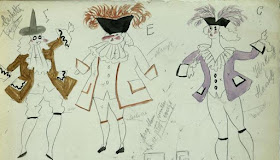 |
| Sketches by Picasso for the first production of Stravinsky's Pulcinella, the ballet from he drew his Suite Italienne for cello and piano. |
REVIEW
Eric Byers and Fabio Bidini, Second Sundays at Two, Rolling Hills United Methodist Church
DAVID J BROWN
 |
| Eric Byers. |
Though the three pieces that comprise Robert Schumann’s late Fantasiestücke Op. 73, written for cello or clarinet and piano over just two days in February 1849, are perhaps too uniform in mood, as well as being rather formally static, to really add up to a multi-movement cello sonata manqué, that very homogeneity brings its own affecting and memorable quality.
 |
| Fabio Bidini. |
 |
| Robert Schumann. |
The central panel of Mr. Byers’ and Sig. Bidini’s tripartite program was Stravinsky’s Suite Italienne. Stravinsky could be a champion recycler, and here he outdid himself. For his 1920 one-act ballet Pulcinella he drew upon music by Pergolesi (1710-1736) and others, and two years later he extracted an eight-movement concert suite from his ballet. In 1925 he returned to this material for a suite for violin and piano, and in 1932-33 did so again for his Suite Italienne, this time in collaboration with the cellist Gregor Piatigorsky.
 |
| Igor Stravinsky. |
After the witty waywardness of the third movement Aria, the Tarantella was a driven moto perpetuo, the Minuetto a tableau of dissonant frozen courtliness, and the Finale a series of rapid-fire alternations of texture, mood, and playing technique, all brilliantly executed.
 |
| David Popper. |
Mr. Byers and Sig. Bidini ended their recital with Popper’s Fantasy on Little Russian Songs Op. 43, which might be better entitled “Variations on a Little Russian Song”—though perhaps amongst the highly virtuosic treatments of the one obvious tune others might have been hidden. After a rhetorical introduction that incorporates both a fast duple-time gopak-like section and a brief cadenza for cello alone, Popper introduces an eloquent minor-key melody, upon which he builds a succession of 11 variations, highly contrasted in mood and pace, and showcasing a dizzying array of cello playing techniques—all of which Mr. Byers showed himself thoroughly master.
It’s good to see the attention now being given by recording companies to Popper’s four Cello Concertos; the RHUMC audience that so enthusiastically acclaimed Mr. Byers’ and Sig. Bidini’s performance of the Fantasy would doubtless equally enjoy of one of them in concert.
After a brief chat with South Bay chamber music entrepreneur Jim Eninger (standing in for the absent RHUMC Music Director Charles Dickerson), Mr. Byers returned alone for a brief encore, a raptly contemplative account of the Allemande second movement from Bach’s Suite No. 6 in D major for solo cello, BWV 1012.
Eric Byers, this time accompanied by Kevin Kwan Loucks, will be repeating the Schumann, Stravinsky, and Popper pieces, together with works by Cassadó and Beethoven, in the final concerts of the South Bay Chamber Music Society 2019-2020 season on April 17/19. For more details, and of other chamber music recitals in the area, please go to "Looking Ahead in the South Bay: Part 2" on this blog.
---ooo---
Rolling Hills United Methodist Church, Torrance, Sunday, January 12, 2020, 2.00 p.m.
Images: Pulcinella: Courtesy City of London Sinfonia; The artists: courtesy Classical Crossroads; Schumann: mfiles; Stravinsky: Wikimedia Commons; Popper: Wikimedia Commons.
If you found this review to be useful, interesting, or
informative, please feel free to Buy Me A Coffee!

No comments:
Post a Comment
Note: Only a member of this blog may post a comment.